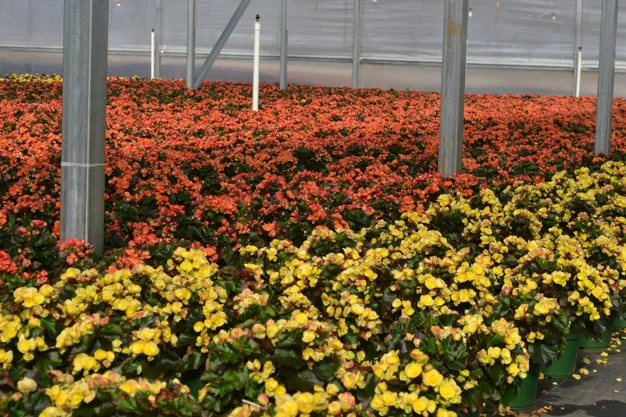A few weeks ago, I had the pleasure of visiting Coach’s Cedar Creek Farm in Lucedale, where I was awestruck by the brightly blooming Amstel begonias growing in one of their greenhouses.
These begonias, also known as Rieger begonias, are a unique blend of tuberous and wax begonias.
As I strolled through the greenhouse, I marveled at the plants’ distinctive mounding form that reaches a modest height of about 12 inches. Their flowers, mostly double or semi-double, presented a ruffled charm with multiple layers of petals.
The glossy, dark green leaves, coupled with their slightly waxy texture, contribute to the overall allure of these begonias.
Among the standout varieties, Amstel Blitz dazzled with delicate, bright yellow petals accented by soft pink highlights. My personal favorite in the Amstel series is Amstel Carneval. Its bi-color orange flowers adorned with yellow centers are a radiant burst of color that can brighten up any indoor space.

What I love about these plants is the endurance of their blooms. These beauties grace us with clusters of flowers for several months, injecting color into indoor spaces during the often-dreary winter and early spring.
In frost-free climates falling under the U.S. Department of Agriculture’s plant hardiness zones 10 through 11, Amstel begonias can be grown as perennials outdoors. Here in Mississippi, you may treat them as annuals or have them as houseplants since these begonias prefer temperatures above 60 degrees.
To grow healthy Amstel begonias, you must maintain consistent soil moisture while avoiding waterlogged or oversaturated soil.
Check the soil moisture regularly. Be sure to water the plant when the soil is not completely dry but not too wet, either. When growing the begonias in pots or containers, ensure that they have adequate drainage holes and are not left standing in water.
Apply fertilizer once a month to ensure that your Amstel begonias bloom abundantly throughout the season.
For this, you can mix half a teaspoon of water-soluble fertilizer in 1 gallon of water and water the plant with this solution. When applying, make sure to pour the mixture at the base of the plant and avoid getting it on the leaves and stems.
Once in a while, throughout the year, the Amstel begonias may get an unkempt or leggy appearance. To address this, prune or pinch the stems so they have just three to five growth nodes. This drastic pruning will help the plants recover, and they should start blooming again in a short period of time.
I also recommend removing withered flowers promptly to encourage the plant to focus its energy on producing new blooms. This will help your begonia continue to bloom vivaciously.
Whether you’re a seasoned gardener or someone just starting to explore the wonders of horticulture, consider adding Amstel begonias to your collection. Their enduring blooms and vibrant colors might be just what you need to brighten up your living space during the colder months.
Source: msstate.edu
